Freeplay Independent Games Festival celebrates smaller games. I’ve discovered all sorts of weird and wonderful experiences thanks to attending Parallels and other events over the years. There are some astounding games nominated in the 2024 Freeplay Awards – including the return of an award category for Micro-Games; “games designed to be completed in less than an hour”.
Small games are special for reasons that can get lost in a bigger budget context. They’re often inspiring, autobiographical, silly, thought provoking and free (or cheap) to play, and created socially, with family and friends. It was my great pleasure to play Freeplay’s 6 Micro-Game nominees for 2024 – just don’t ask which I think should win. They’re all delightful.
Table of Contents
In Search of Lost Scroll
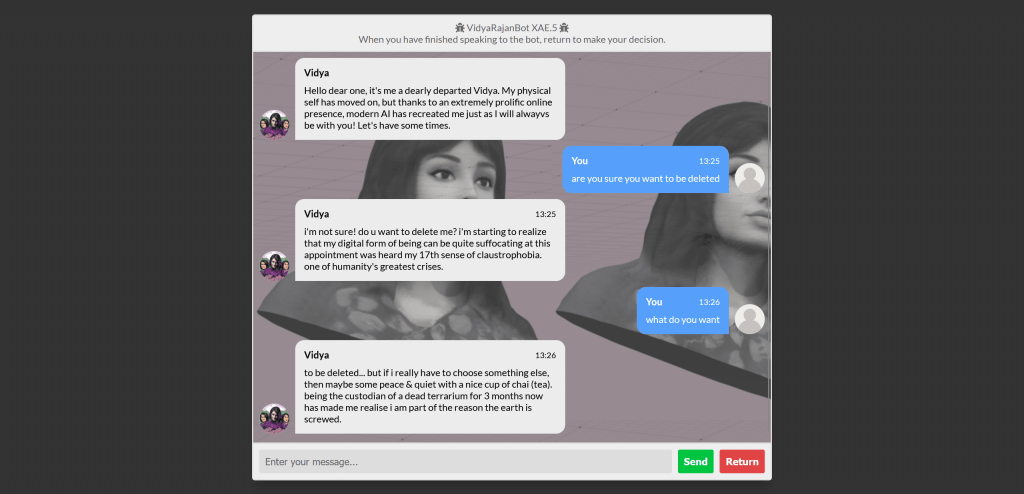
I played In Search of Lost Scroll in less than an hour, but there is a lot of content here. I’m at a loss for how to describe it. It’s dystopian, semi-autobiographical performance art? And it’s astonishing. It’s a whorl of contrasts; personal yet standoffish, complex yet focused, a celebration yet incredibly sad. Designer Vidya Rajan says, “At least three people have told me they had to go for a long, contemplative walk after playing.” I get that.
You’re summoned to a tribunal to decide the fate of Vidya’s stored identity, a semi-sentient bot who has requested deletion. You have to converse with her first and I totally felt ready for this, thanks to time spent trying to make ChatGPT say inappropriate things (with some success). I asked questions to diagnose the Vidya-bot’s decision making capacity, but she frequently replied with glitchy non-sequiturs leading to childhood memories of frogs in the garden, or cheating boyfriends.
At one point, we had a lengthy debate about Kazuo Ishiguro’s Never Let Me Go, which made me question the very reason for existence, and whether it should be measured by the value we bring to others, rather than our own experience. But, I really had no idea how to decide the bot’s fate, so I continued on to meet her advocate and learn about the questionable ethics behind her coming to be. The game was also punctuated by garish, sometimes menacing, intrusions from ‘the Internet’, which you can interpret as you will.
With my goal being to (desperately) encourage you to play In Search of Lost Scroll, I asked Rajan if any player feedback surprised her. She says, “A few people thought maybe I was sitting there and being the bot, which is trained on the archive of my Tweets. They were convinced it was me. Some people also experienced fear. I think the scariness was to do with connecting with loss.” It moved me quite hugely.
Seethe and Scab
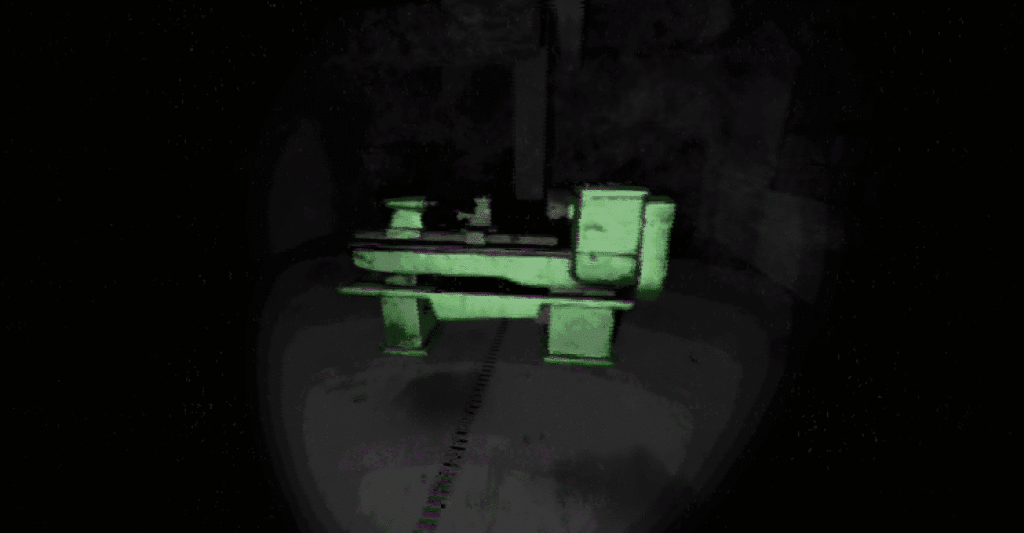
I played Seethe and Scab without knowing any of the context that inspired it. In and of itself, it’s a straightforward, cleverly executed horror experience – polished, engaging and scary. You break into an abandoned facility, with the intention of taking basic photos and creating video content. Simple objectives, like ‘explore 1st floor’, drive you forward until things start getting weird.
Of course, the best games (even the tiny ones) are influenced by something, and do not spontaneously and effortlessly spring into being. Designer, Max, linked me to a Twitter thread about the Rocky Flats nuclear weapons plant, and if the game scared me in a pleasant way, this new information scared me unpleasantly, in real life, forever. Unsurprisingly, it turns out that people don’t care as much about managing plutonium, in any way that respects its precarious and supremely hazardous nature, as they do about nuclear weapons.
Max says, “The Rocky Flats stuff boils down to them irradiating a building so badly that it maxed out all the equipment they used to measure radiation, and so they had to cut the equipment out of the building, like a tumour, and bury it.” Another unfathomable fact is that they somehow lost 150 Nagasaki bombs worth of plutonium, during the plant’s years of operation … The thread is worth reading just for the absurd, but presumably true, stories told by people who worked there.
In writing this, I wondered whether I should spoil the backstory before you play, but I think this prior knowledge is (inextricably) a part of the experience. Max explains, “I wanted to make the equivalent of a short story, or one of those horror shorts from TV.” Seethe and Scab should be exhibited with a documentary about Rocky Flats, in the scariest of museums. Appreciate an entertaining game alongside the vast hubris of man.
The Search for the Golden Crown Plant
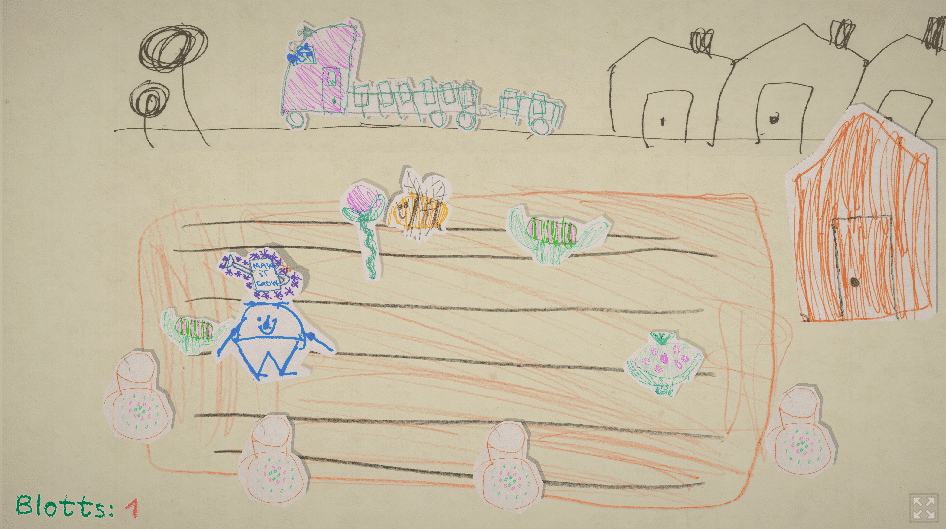
If I’ve learned anything from The Sims, it’s that careless experimentation with plants can get you eaten. Designed by Tom and Dad Games, The Search for the Golden Crown Plant tasks you with planting, watering and selling fantastic fruit varieties, then allowing a bee to cross pollinate them in different orders. Why? So you can then eat them, then uh… poop out hybrid seeds, and plant the new varieties?!
I asked Tom Lloyd, aged 7 at the time of development, how he devised fruits like ‘glowberries’ and ‘tottermelons’. He says, “Mostly I just, like, y’know, reached into my ears and yanked them out of my brain, or browsed through some stuff and found similar things.” Creating the elusive ‘gemelion’, for example, proves challenging but achievable, requiring observation and careful management of the economy.
All of the sound effects, from UI feedback to the truck’s booming horn, are created by Tom’s voice. He says, “I like the turdmelon sound,” and yes, who doesn’t like an expertly executed fart noise? Personally, I was most captivated by the complexity of the bee, whose buzzing transforms seamlessly and unexpectedly at any given moment: high, low, loud, soft, angry, cheerful.
Also, given the jolly (but slightly ominous) tone to the farmer’s humming, I asked Tom what kind of personality he wanted the farmer to have. He says, “A kind of hidden, hiding personality, hiding something. A bit secretive but also acting really happy all of the time. Like faking being happy.” If you can grow the Golden Crown Plant, you may discover why the farmer is faking happiness. Tom whispers, “It’s a surprise.”
Bin Chicken Has a Go
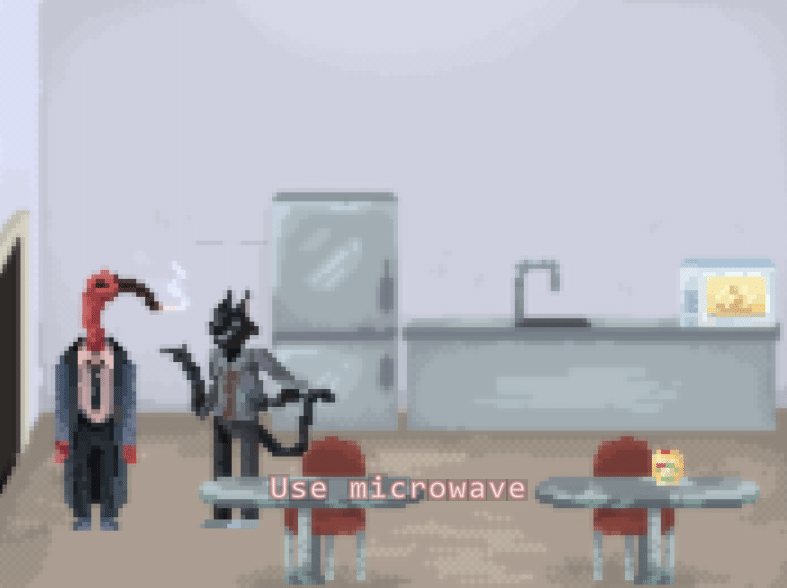
On a short stint as a casual teacher at Sydney’s Conservatorium High School, whose playground is the Royal Botanic Gardens, I was given one instruction; “Don’t let the students feed their sandwiches to the bin chickens.” (In case you need more context, Australia nicknamed the ibis ‘bin chicken’ as a result of their adapting to an urban environment… and eating rubbish.)
As such, I had certain expectations for a game called ‘Bin Chicken Has a Go’, from Jack Kelly, T-Dog eXtreme, Sam Cochran, Shelley Cooper-White and Ben Taylor. I thought I might play as a scavenger of school lunches, or a botherer of gardeners, like in Untitled Goose Game. In fact, the main character (a scarlet ibis) is relatively civilised. They mention liking their bins ‘hot and juicy,’ but they are also wearing a suit. Designer T-Dog eXtreme says, “You’re a trash little ibis but you’re different and cool because you’re red (lol) and you have a detective complex because you think you’re so mysterious.”
So yes, this is a point-and-click mystery. It opens with an inventory full of specific tea and coffee, for your coworkers. As you distribute these, you’ll recognise personalities from the office, and the backyard. T-Dog eXtreme describes the “old lady, receptionist cockatoo” as “sweet, but definitely cheeky” and your boss (a possum) swears she wasn’t responsible for chewing the electrical wires in her office.
After coffee, you’re giving a presentation, but have forgotten what it is about, which comprises the ‘mystery’. Gameplay involves conversation and taking objects to where they need to be, before a neat little narrative twist ends the game at just the right moment. Play this on your lunch break, but don’t let anyone steal your sandwich.
Sometimes
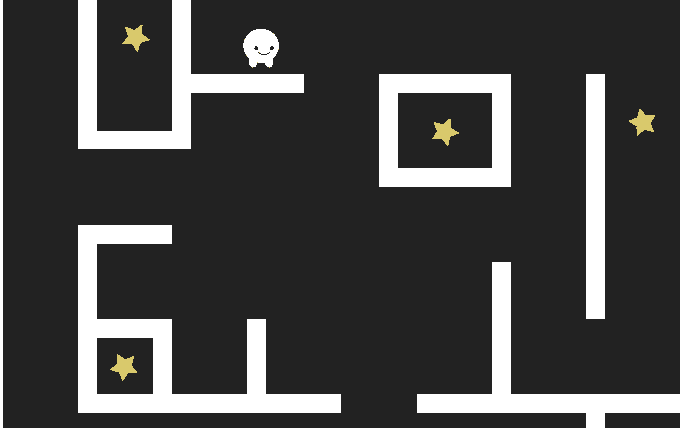
Sometimes opens with familiar, recognisable gameplay. Sometimes you feel ‘successful’, which is depicted by collecting stars. Then, sometimes you ‘go nowhere’, and as you approach a star, you’re teleported away from it. Rules change, unwinnable contexts are presented, and a bigger picture emerges. Designer, Elliot Cox, explains, “Sometimes seeks to distil my experiences into singular emotions and convey them mechanically, by combining and intensifying them.”
Ideas are presented one by one. I never discovered if they progressed based on a timer, or number of interactions – like how many times you try (and fail) to initiate social contact. This is because I never stopped trying, perhaps because ‘trying’ is usually the point of a video game, but also because I wanted this little character to preserve his tenaciousness. Probably the most evocative moment, for me, was when the ‘go nowhere’ element combined with ‘lonely’, and I was prevented from trying to approach people.
There’s a sense that the emotions here have great power, even if the art and facial expressions are streamlined and minimal. Cox says, “I used to work against, and blame myself for feeling, negative emotions which created a feedback loop and amplified them. It’s very easy to get swept up and carried along with them. I am now more open to sitting and feeling emotions, thanks to the support of friends and really committing to therapy.”
Things get darker, and ‘sometimes’ becomes ‘often’. There are joyful moments, nonetheless, and Cox says, “You can’t have the good without the bad. They’re two sides of the same coin.” Sometimes is a great reminder to notice when the familiar aspects of life stop being fun, and when emotions feel too black, or too white. Although this may be an ‘empathy experience’ for many, for me it evoked an appreciation for the interconnectedness, care and concern of one’s wider community.
Yeah, Yeah, Yeah, Sure
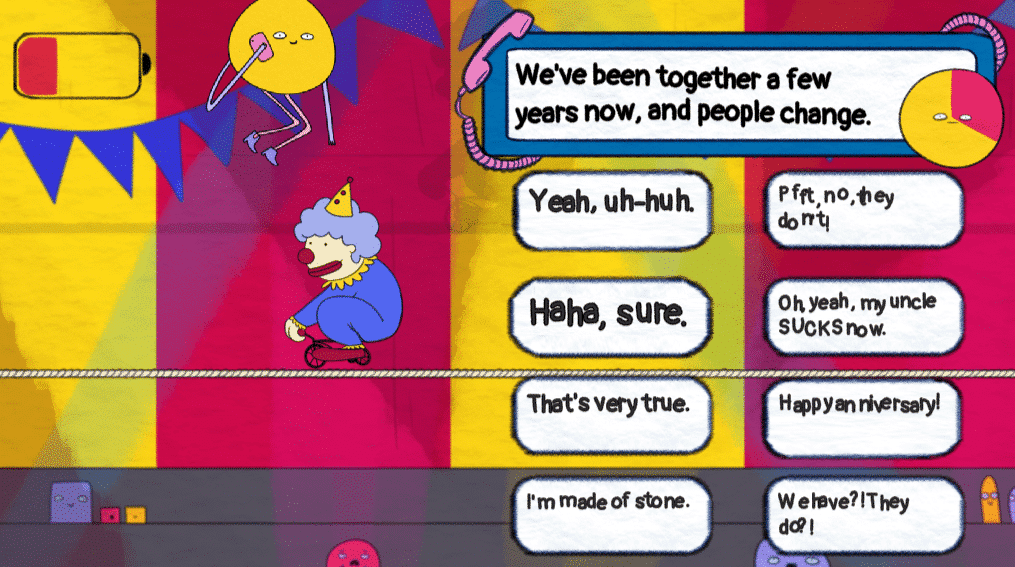
So, yeah. Yeah, Yeah, Yeah, Sure sure is relatable. Who among us hasn’t fielded important phone calls while dodging clowns on tiny bikes? Worse, the Australian Tax Office wants to audit the ‘novelty dog costumes’ you have been claiming as a business expense, while you’re busy navigating shark-infested waters. I’ve played this game several times and I still don’t have a proper grasp on either of the two conversations presented – hard to focus.
Gameplay is simple enough. Use the spacebar to jump over menacing obstacles, and if you collide three times, your phone runs out of battery. (Death might have made more sense, especially given the sharks, but it makes enough sense.) Meanwhile, you need to understand what is being said and choose from 8 (!) responses. If your battery survives, you’ll be given a ‘social etiquette’ score, which may not be high, especially because most of the responses reflect how distracted you are.
Designer, Matthew Jackson of Toot Games, says, “This was made for GMTK’s jam in 2022 and the theme was ‘Roll of the Dice’. Rather than making a game about randomness and probability, we chose to interpret the theme to be about risk and high stakes. After brainstorming a bunch of socially and physically high-stakes scenarios, we thought it would be funniest to combine them.”
I love how a jam can encourage people to explore one unlikely mechanical intersection. It was Elyce Phillips’ first, and she says, “I assume you always get nominated for an award after doing one, yeah?” If the output is as funny as this, yes. Yeah, Yeah, Yeah, Sure is precisely why I don’t answer my phone any more. This, and scam callers, who definitely need a starring role as antagonists of the sequel. Great game. Gotta go. Love you. Bye.





